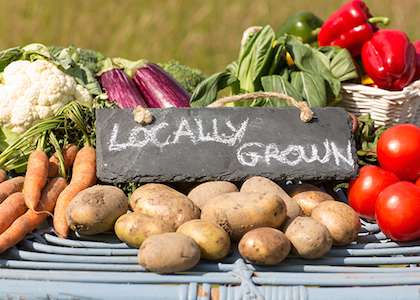
3 Big Reasons We Love Farmers Markets & Local Produce
By Isabel Smith, MS, RD, CDN
With spring, comes a flood of seasonal farmers markets, which means it’s easier for you to access farm-fresh produce. If you’re wondering why farmers markets may just be the greatest thing to pop up in your neighborhood this spring, here are 3 big reasons why you should seek out your local farmers market:
1. Fresher Produce:
Farm-fresh produce tends to be seasonal and is more likely to have been recently picked, which means that you’ll be giving your body more nutrition. Much conventionally-grown produce is picked then sits on a truck, or at a warehouse for weeks at a time before you find it on your local grocery store shelf. When produce sits for a long period of time, the amount of nutrients in the produce decreases depending on how long it is allowed to sit for before heading to market. Lastly, farm-fresh produce is more likely to last longer in your refrigerator or on your counter because it’s more recently picked, so you get more longevity out of your fruits and vegetables, which means less frequent trips to the shops.
2. Fewer Pesticides:
Farm-fresh produce grown at smaller farms is less likely to have as many pesticides as conventionally grown produce. Conventionally grown produce here in the United States has to adhere to certain standards when it comes to not using certain pesticides that are known to be carcinogenic; however, produce that is coming from other countries doesn’t necessarily have to adhere to those standards. Regardless of where it comes from, fewer pesticides are better for our health, which is one of the major reasons to seek out farm-fresh produce available at your local farmers market.
3. Less Expensive:
One of the most common reasons for people to not purchase organic produce is because of its high cost. The good news with farm-fresh produce is that it’s less likely to be as costly; it may still be slightly more expensive than conventionally grown produce, but often is competitively priced with commercially-grown produce, and in some cases can be less expensive. Another great offering from many farms in the spring and summertime is to be part of a CSA (Community Supported Agriculture). CSA’s will be slightly different when purchased from different farms, but are usually a way to get farm-fresh produce, and whatever produce is in season, delivered on a weekly or bi-monthly basis. Another great reason to become part of a CSA is that it’s a great way to support your local economy.
How do I find a farmer’s market?
This great website allows you to search for farmers-markets in your area: https://www.localharvest.org/farmers-markets/
If you’re unable to get to a farmers market, here’s what you need to know about purchasing organic produce…
There are certain fruits and vegetables that are known to carry more pesticides, often called the “Dirty Dozen” by the Environmental Working Group. If you’re unable to purchase these fruits and vegetables from a locally-grown source, you can seek them out in the organic food aisle.
1.) Apples
2.) Celery
3.) Cherry tomatoes
4.) Cucumbers
5.) Grapes
6.) Hot peppers
7.) Imported nectarines
8.) Peaches
9.) Potatoes
10.) Spinach
11.) Strawberries
12.) Sweet bell peppers
13.) Kale/collard greens
14.) Summer squash
If you’re unable to purchase the “Dirty Dozen” either locally or organic, wash them well…
If you’re unable to purchase those fruits and vegetables above that tend to carry more pesticides from either a local or organic source, make sure you wash them well. Running water and a clean sponge or brush does a great job at cleaning, but so does a basic fruit and vegetable wash made from the following ingredients:
1 part water
1 part vinegar
Note: The best way to use this wash is either to scrub the produce in the wash or to pour the wash over the produce; soaking the produce in the water for a longer period of time can cause some of the nutrients to leech out into the water and be lost when the water is disposed of.
If you have extra space in your yard or at your home…
Plant your own fruits and vegetables, which can help ensure they’re grown without added pesticides. Here’s a list of easy-to-grow fruits and vegetables:
1.) Basil: Grows best in the sun or in a warm environment, and can be grown either in a pot or in the ground.
2.) Carrots: Grow best in cooler weather, and are one of the easiest vegetables to grow.
3.) Lettuce: Can also be grown in a pot or in the ground and are very easy to grow, as they grow quickly.
4.) Tomatoes: A grow-at-home favorite, tomatoes are also easy to grow and require a warm and sunny place.
5.) Peppers: Similar to tomatoes, they require a warm and sunny place to grow but are relatively easy to grow and are so tasty. They also come in many shapes and sizes.
6.) Raspberries: More delicate, but also easy to grow. They like to be grown in a minimally-windy location with plenty of warmth and light.
7.) Strawberries: A very versatile and easy fruit to grow because they can be grown in a pot, in the garden, or in a hanging basket. They are best planted in April and May and grow nice flowers as well.
8.) Squash: Also easy to grow and grows well in more sheltered locations out of the wind and weather.
9.) Cabbage: Cabbage likes plenty of water and grows best in the spring and fall, and in fact is one of the most frost-resistant plants you can grow, so it does particularly well in colder temperatures.
10.) Mint: Can be grown both inside and outside and can even grow all year long. Mint is versatile, can be added to various recipes and has great digestive properties.